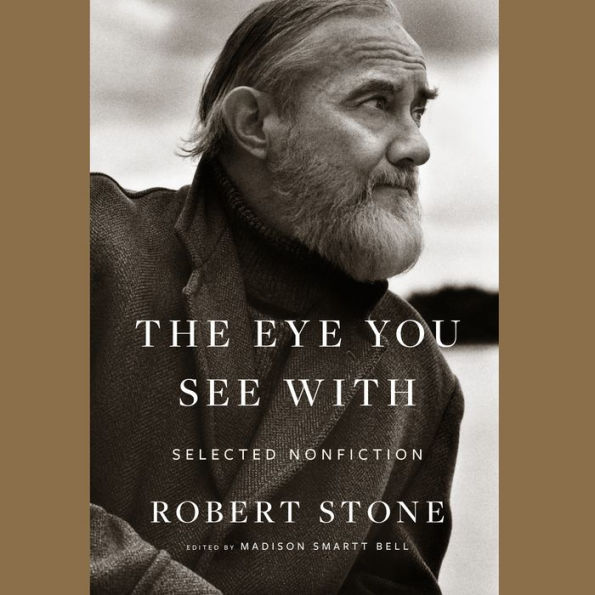Robert Fass presents this far-ranging audiobook with a sureness of tone. His pace adjusts to the variety of pieces by the late author Robert Stone—personal essays, reports on conventions, sketches on locales from Vietnam to New Orleans, as well as introductions to books. The listener gets to know the gifted novelist and close observer of American life from the inside out. Fass’s delivery feels like he has penetrated Stone’s consciousness. The narration smoothly renders Stone’s thoughts as the awarding-winning writer unspools his reflections on his Catholic boyhood, his time with Ken Kesey, his experience as a census taker, and, most fervently, his takes on Stephen Crane, Graham Greene, and George Orwell. Editor Madison Smartt Bell, Stone’s biographer, adds explanations, explications, and an occasional correction to Stone’s memories in this captivating audiobook. A.D.M. © AudioFile 2020, Portland, Maine
The definitive collection of nonfiction-from war reporting to literary criticism to the sharpest political writing-from the “legend of American letters” (Vanity Fair)
Robert Stone was a singular American writer, a visionary whose award-winning novels-including Dog Soldiers, Outerbridge Reach, and Damascus Gate-earned him comparisons to literary lions ranging from Samuel Beckett to Ernest Hemingway to Graham Greene. Stone had*an almost prophetic grasp of the spirit of his age, which he captured with crystalline clarity in each of his novels. Of course, he was also a sharp and brilliant observer of American life, and his*nonfiction writing is*revelatory.**
*
The Eye You See With-the first and only collection of Robert Stone's nonfiction-was carefully selected by award-winning novelist and*Stone biographer Madison Smartt Bell. Divided into three sections, the collection includes the best of Stone's war reporting, his writing on social change, and his reflections on the art of fiction. This is an extraordinary volume that offers up*a clear-eyed look at the 20th century and secures Robert Stone's*place as one of the most original figures in all of American letters.*
Two-time winner of the prestigious Audie Award as well as numerous*AudioFile* Earphones Awards, veteran actor*Robert*Fass*has narrated over 200 unabridged audiobooks by modern and classic fiction writers such as Ray Bradbury, John Steinbeck, Saul Bellow, T.S. Eliot, Joyce Carol Oates, Carlos Fuentes, Jeffrey Deaver, and Lee Child, as well as bestselling and prize-winning nonfiction works in history, politics, health, journalism, philosophy, business, and memoir.
*
The definitive collection of nonfiction-from war reporting to literary criticism to the sharpest political writing-from the “legend of American letters” (Vanity Fair)
Robert Stone was a singular American writer, a visionary whose award-winning novels-including Dog Soldiers, Outerbridge Reach, and Damascus Gate-earned him comparisons to literary lions ranging from Samuel Beckett to Ernest Hemingway to Graham Greene. Stone had*an almost prophetic grasp of the spirit of his age, which he captured with crystalline clarity in each of his novels. Of course, he was also a sharp and brilliant observer of American life, and his*nonfiction writing is*revelatory.**
*
The Eye You See With-the first and only collection of Robert Stone's nonfiction-was carefully selected by award-winning novelist and*Stone biographer Madison Smartt Bell. Divided into three sections, the collection includes the best of Stone's war reporting, his writing on social change, and his reflections on the art of fiction. This is an extraordinary volume that offers up*a clear-eyed look at the 20th century and secures Robert Stone's*place as one of the most original figures in all of American letters.*
Two-time winner of the prestigious Audie Award as well as numerous*AudioFile* Earphones Awards, veteran actor*Robert*Fass*has narrated over 200 unabridged audiobooks by modern and classic fiction writers such as Ray Bradbury, John Steinbeck, Saul Bellow, T.S. Eliot, Joyce Carol Oates, Carlos Fuentes, Jeffrey Deaver, and Lee Child, as well as bestselling and prize-winning nonfiction works in history, politics, health, journalism, philosophy, business, and memoir.
*

The Eye You See With: Selected Nonfiction

The Eye You See With: Selected Nonfiction
FREE
with a B&N Audiobooks Subscription

Editorial Reviews
Product Details
| BN ID: | 2940175805698 |
|---|---|
| Publisher: | HarperCollins Publishers |
| Publication date: | 03/03/2020 |
| Edition description: | Unabridged |
Videos

